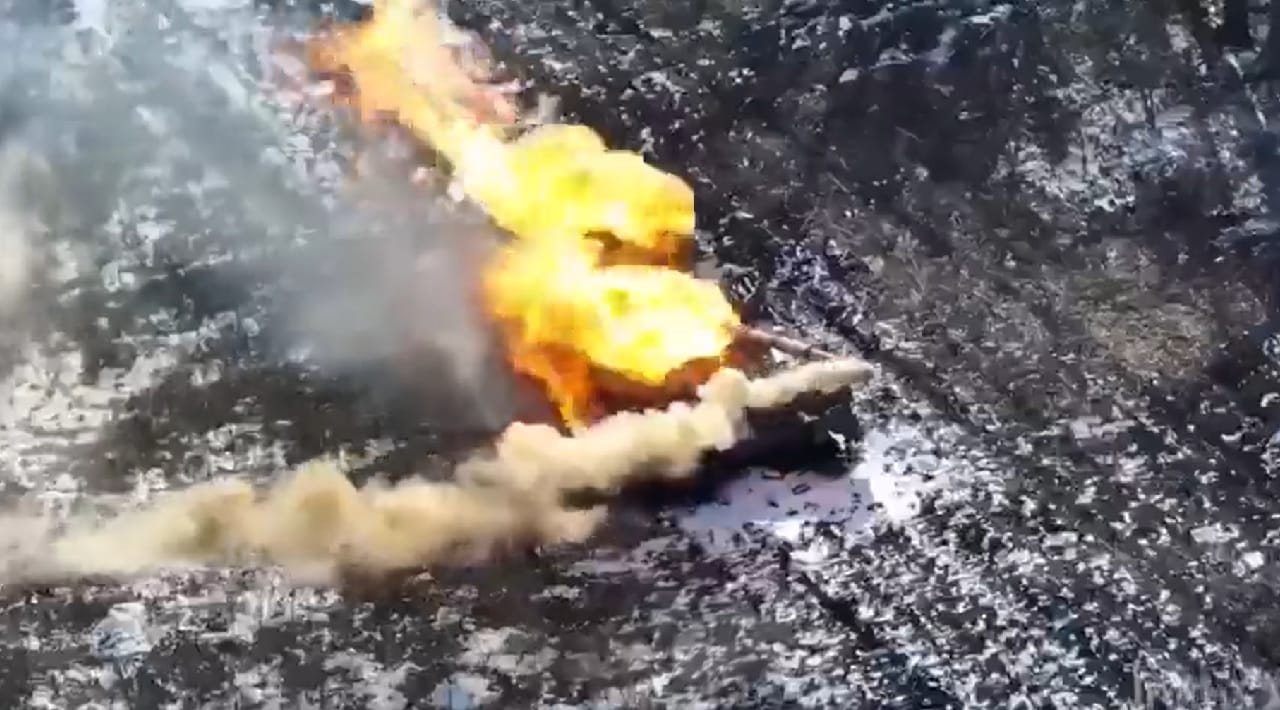A video shared on social media by Ukraine Weapons Tracker (@UAWeapons) on Tuesday showed how an unmanned aerial vehicle (UAV) was still able to find a reasonably well-concealed BMP-1 infantry fighting vehicle (IFV) that took cover south of the village of Opytne in the Donetsk Oblast.
The drone spotted the IFV and then dropped multiple 40x53mm HEDP (high-explosive, dual-purpose) grenades into an open hatch.
The settlement, located about two kilometers (one mile) north of the Donetsk airfield, has been nearly completely wiped off the map in recent fighting. Since November 2014, Opytne – which had a pre-war population of 755 – has never been fully under Ukrainian control.
As of this year, almost all of its structures have been razed to the ground.
Grenades Away
The ordnance is an impact-type round that can penetrate up to two inches of steel armor at 0-degree obliquity and inflicts personnel casualties in the target area.
The attack on the BMP-1 was reportedly carried out by soldiers of the Ukrainian 110th Mechanized Brigade, a unit that was formed last year following Russia’s unprovoked invasion. Named in honor of Colonel-General Marko Bezruchko, military commander of the Ukrainian National Republic, it initially used equipment donated or purchased from the Czech Republic. The unit has widely shared its exploits on social media, and last month was noted for destroying a Russian Mi-24 helicopter in the Donetsk Oblast.
The 110th Mechanized Brigade continues to hunt disabled Russian tanks and armored personnel carriers (APCs) and other armored platforms, employing commercial off-the-shelf drones to ensure that the vehicles can’t be recovered by Kremlin forces and returned to service.
As a result of drone attacks, both sides have increased the use of camouflage and concealment, but as noted in Tuesday’s video, those efforts fell short. It is unclear if the crew was inside the BMP-1 when it was targeted in the low-level drone strike.
Cold War Vehicles
Russia has been equipping its forces with hundreds of Cold War-era BMP-1 IFVs, a platform first introduced in 1966. It was designed to combine the properties of an APC and a light tank to allow infantry to operate from the relative safety of the vehicle’s armored, radiation-shielded interior in contaminated areas, and to fight alongside it in uncontaminated areas.
The primary armament of the BMP-1 is its turret-mounted 73mm (2.87-inch) short-recoil gun, which was fed with fin-stabilized rocket-assisted ammunition from a 40-round magazine. The weapon was also developed with a low-pressure system to negate excessive backblast into the cabin.
Though its primary user was the Soviet Union, the BMP-1 was actually first employed in combat in the 1973 Yom Kippur War in Egyptian and Syrian service – but with mixed results. A number of vehicles were lost due to technical failures, while the crews weren’t likely properly trained to best utilize the IFV in combat.
Despite the fact that it didn’t meet expectations in the Soviet-Afghan War, where it proved unsuited to the mountainous regions, thousands have remained in service throughout the world including in Russia, India, and the People’s Republic of China.
Last month, it was also reported that Greece would provide a number of Soviet-era BMP-1 IFVs that it had in its arsenal to Ukraine. In the early 1990s, the Hellenic Army had received the vehicles from the German military – inherited from East Germany at the end of the Cold War.
#Ukraine: South of Opytne, #Donetsk Oblast, a camouflaged Russian BMP-1 infantry fighting vehicle was destroyed by the Ukrainian 110th Mechanized Brigade using several 40x53mm HEDP grenades dropped from a drone through an opened hatch. pic.twitter.com/wch4B5ZilC
— ???????? Ukraine Weapons Tracker (@UAWeapons) May 2, 2023
Perhaps Kyiv’s forces will determine a better way of camouflaging them.
Author Experience and Expertise:
A Senior Editor for 19FortyFive, Peter Suciu is a Michigan-based writer. He has contributed to more than four dozen magazines, newspapers, and websites with over 3,200 published pieces over a twenty-year career in journalism. He regularly writes about military hardware, firearms history, cybersecurity, politics, and international affairs. Peter is also a Contributing Writer for Forbes and Clearance Jobs. You can follow him on Twitter: @PeterSuciu.

